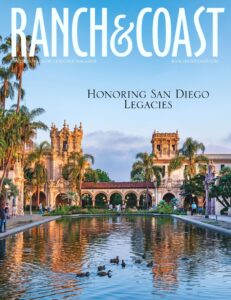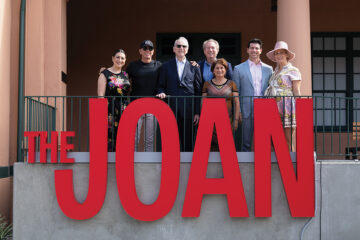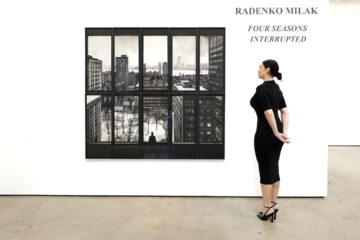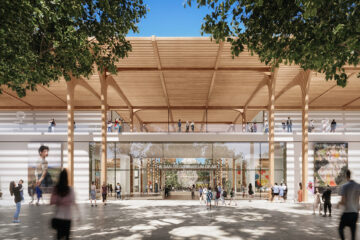Gaslamp Ladies

Gaslamp Ladies
In honor of Women’s History Month in March, we take a look back at stories of ten women who made their mark in San Diego’s emerging Gaslamp District
By Darlene G. Davies with Anne Hoiberg
Posted February 27, 2019
In the historical narrative of the Gaslamp Quarter, women played key roles, frequently behind the scenes, but often in front as well. Famous and infamous, ladies were there. It was a man named William Heath Davis who had the notion of creating a New Town near San Diego’s waterfront, and with other visionaries including Alonzo Horton, the shift from what is now Old Town, situated below San Diego’s Presidio near Mission Valley, to what is now Downtown, began. The adventuresome New Town was a place where entrepreneurs created a booming new city comprising 16½ blocks and 93 buildings alongside San Diego’s magnificent port. No doubt, the creation of what is today known as the Gaslamp District was initially driven by men, but women also left their prints on that section of town in the 19th, 20th, and into the 21st centuries. Ten of these fascinating women are celebrated here.

One famous lady, Dr. Charlotte Baker, was an obstetrician who moved to San Diego in 1888 with her husband, Fred, also a doctor. The two physicians worked from their home on Seventh Street, between F and G. Baker vehemently opposed the Stingaree “red light” district and worked with the Purity League and other citizens to shut it down. Baker’s reasons were medical, specifically to prevent or slow the spread of disease. For others, however, opposition to the Stingaree brothels was linked to the negative image of San Diego it projected toward visitors. A strong champion of women, Baker, while also working full time as a physician, served as President of the San Diego Equal Suffrage Association in 1911. Here was a professional woman way ahead of her time who took on civic duties in addition to practicing medicine. That meant that while delivering babies and treating patients, she also doggedly went on a speaking tour of San Diego County to convince men to support a woman’s right to vote. The men delivered and California joined five other states in recognizing a woman’s right to vote. Baker also played an important role in establishing the local Y.W.C.A, having been a co-founder and honorary member. This impressive woman lived from 1855 to 1937, dying at the age of 82. Not a minute was wasted as she pursued a life dedicated to others. In contemporary language there is frequent reference to purpose-driven lives. Baker certainly led a purpose driven life.


The “real” Ramona of Helen Hunt Jackson’s best-selling 1884 novel of the same name lived in the Gaslamp Quarter for a time. According to historian Anne Hoiberg, Ramona Wolf, a half Chumash Indian, was believed to be the woman on whom Jackson based her heroine. Jackson resided with the Wolfs in Temecula in the early 1880s, and her work focuses on the terrible treatment of Native Americans at that time. The novel is a love story that also records the displacement of the Temecula natives from their native land. After the death of her husband, Louis, Wolf lived in the Gaslamp while the courts settled her husband’s estate. Somewhat ironically, the fictional and popular Ramona’s Marriage place is in Old Town. Set in Casa de Estudillo, it is a place of fabled romance that has long attracted tourists.
In contrast to the greatly admired Dr. Charlotte Baker, consider the infamous Ida Bailey, a madame of an upscale brothel that went by the name of Canary Cottage. Located at 530 Fourth Street in the Stingaree District, this house of ill repute was frequented by some of San Diego’s most prominent men. Reportedly, the ladies of Canary Cottage dressed up every evening as if they were on their way to theatre or other cultural events. Clients were referred to as “gentlemen callers,” and the conversations were laced with sophistication. It is said the mayor and chief of police were among the Cottage’s clientele, so that Bailey was likely assured protection, something that may explain the longevity of her business. Despite public pressure from community citizens and the Purity League to close the Stingaree, it took a long time. A raid of the Stingaree in 1912 resulted in well more than 100 arrests, all in anticipation of the 1915 Panama-California Exposition in Balboa Park. At the time, there was great concern about the area below Broadway and what visitors might see when visiting the upcoming fair. These clean-up efforts increased in the mid-20th century and extended into to the 1970s, enabling the historic revitalization of Gaslamp Quarter that now attracts hundreds of thousands of visitors a year. Fittingly, the theme chosen for the area was Victorian. From 19th and 20th century gamblers, robbers, and houses of prostitution to 21st century eateries, music, and historical tours, the Gaslamp brims with energy. Not to be missed, Ida Bailey is one of the historic figures currently portrayed by the Gaslamp Players, a troupe of actors who travel the city bringing to life early historical figures from the storied area once known as New Town.
Lydia Knapp Horton gets the credit for getting a library built. She dreamed of a library that would have its own home, not a temporary one where it was treated as a stepchild by other city services. She shared her dream with the women members of the Wednesday Club and in 1897 wrote a persuasive letter to Andrew Carnegie requesting money to build a permanent library. Carnegie sent a total of $60,000 for construction of the building and the purchase of book stacks, a great deal of money in those days. The City of San Diego paid part of the $17,000 for the land at Eighth and E Streets, with the rest of the funds coming from private donations. George Marston donated $1,000 and the Wednesday Club gave $500. Knapp Horton had served as the first president of the Wednesday Club. Construction commenced in 1900 and the library opened two years later. The result was a beautiful and popular building in Classic Revival Style, the first Carnegie Library in California. Inside was a children’s room, a women’s magazine room, and a men’s magazine room. Separate rooms for men and women were standard at that time. The new wrinkle was that visitors could walk through the book stacks selecting books themselves rather than having to rely on librarians to find them. Knapp Horton was the initiator of this project, the woman who put the dream into motion, and saw it through to fruition. Like the others mentioned, she made a difference.
Compare the activities of Madame Ida Bailey of Canary Cottage to the heroic service of Margaret Fanton within the Gaslamp’s Chinese community. After teaching there, Fanton assumed the post of Superintendent of the Chinese Mission School in 1911. She provided English and Sunday School lessons, but she was much more than a teacher during her nearly 40 years of work. Fanton was really a social worker before such a title existed. The Chinese of the red-light district lived in squalor and Fanton was determined to help. Though she left the superintendent position because of declining health in 1919, she continued to serve the school and community until 1935. Her focus was the welfare of others.
There is a remarkable story attached to California’s first woman attorney, Clara Shortridge Foltz, whose law office was in the Nesmith-Greely Building on Fifth Avenue between E and F Streets. Foltz became a teacher in the Midwest when in her early teens, married at 15, and moved to California, but she and her five children were abandoned by her husband. She earned money by giving speeches on topics of women’s rights and, evidently, was an impressive orator. Because she was so attracted to the law, she worked for a judge, and then she and another woman applied to Hastings School of Law for admission. Though a brave and progressive step, they must have surmised the response and were likely not surprised when the school turned them down. Women were not admitted to law school in those days, but Foltz sued, delivering her own argument. She was allowed to enroll at Hastings as a result, but by that time, the two women had already passed the bar exam, making Foltz the very first woman attorney in the state of California. This was a huge step forward for women. Foltz then wrote the California Women’s Lawyer’s Bill that deleted the words “white male” and replaced them with “person.” Foltz made sure the governor signed the bill. This progressive woman also oversaw the San Diego Bee, a daily newspaper, and wrote the California Women’s Vote Amendment in 1911. That same year, California, as mentioned above, became the sixth state to recognize a woman’s right to vote. Foltz also gave her name to the 1921 Foltz Defender Bill, ensuring assistance to indigent criminal defendants in California, a bill that has had national importance. Foltz’s life is a lesson in tenacity and endurance.
The original Marston’s department store was in the Gaslamp at Fifth Avenue and F Street. The building is still standing and included on tours. Anna Gunn Marston, George Marston’s wife, was a civic leader alongside her noted husband. She was president of the Congregational Women’s Missionary Society of Southern California and a board member of the San Diego Children’s Home. While her merchant husband became financially successful, he also strongly influenced the creation of Balboa Park and was a founder of the San Diego Historical Society (now the San Diego History Center). Anna assisted him in his many endeavors in addition to her own extensive community involvement, and future generations of Marstons would be stewards of San Diego as well, including Mary and Peg Marston.
Toward the close of the 1880s, six years after the famed gunfight at the O.K. Corral, Josie Earp lived with Wyatt Earp at the Brooklyn Hotel, now part of the Horton Grand. Histories cite 1887 as the year they first moved to San Diego, living in a house they likely rented. There is no record of a marriage license and historians have found no other proof of their being married, but Josie used the famed lawman’s name. Josie had experienced the rough and tumble wild west as a young woman, touring in a theatre troupe. Like Earp, she was a confirmed gambler, and the two were known to frequent gambling houses. They were together for several decades and moved to Hollywood in the 1920s.
Now leap ahead to 1977 when Kit Goldman became involved with the feminist Women’s Theatre Ensemble, anchored in the Second Avenue Theatre that would become Horton Plaza. Her partners in the undertaking were two men, the remarkable Will Simpson and Robert Earl. The trio began to look for a new home, venturing south of Market Street, where Goldman saw a largely abandoned area, with only a Goodwill center, the Rescue Mission, and a Cost Plus further to south. The sidewalks were in disrepair and streetlights were missing. It was not an encouraging sight, and Goldman describes the bleak scene in her talks about creating a Gaslamp Quarter Theatre. Nevertheless, she and her colleagues had a vision, and while they had no money, their friends and business associates were willing to take the gamble. Whoopi Goldberg, an actor with a San Diego background, performed as part of a fundraiser for the project. From a well of hope and determination, the first Gaslamp Quarter Theatre opened, a 96-seat venue in the Pacifica Hotel at 547 Fourth Avenue that was occupied by dance hall at one time. The Gaslamp Quarter Theatre was determined to pay its actors and not ask them to perform as volunteers, not easily achieved with few monetary resources. Goldman’s dream, however modest, had come to fruition. At that time, however, there was still fear on the part of theatre-goers regarding the area. People were afraid to venture into unknown territory with all the often-related tales of urban danger. Nevertheless, Goldman, businessman Dan Pearson, and colleagues established a second larger theatre in the Paper Box Building around the corner from the reconstructed Horton Grand Hotel. They raised $2 million for construction and hundreds of thousands of additional dollars for operations, and the new theatre opened at the end of 1986. Initially named the Deane Horton Grand Theatre, then the Hahn Cosmopolitan Theatre, and finally, simply, the Horton Grand, it was the site of many productions by Goldman. Together, she and Pearson were central to the reconstruction of the Horton Grand Hotel at Fourth Avenue and Island. Until recently, the hotel’s restaurant was named for the infamous madame Ida Bailey. Goldman left the Horton Grand Theatre in 1992, having produced myriad plays. By that time, the small first theatre had closed so the group could focus on the larger one. Goldman was truly a pioneer when it comes to arts in the Gaslamp. This past year, 2018, both Pearson and Goldman gave talks to the Gaslamp Quarter Historical Association, which offers monthly lectures.
 There are many resources and stories of the Gaslamp Quarter continue to be gathered and shared. Women of the Gaslamp Walking Tours, hosted by the Women’s Museum of California, are led by Anne Hoiberg on the third Saturday of each month. Hoiberg, who has been researching women’s history for many years, authored an illustrated booklet The Women of the Gaslamp Quarter. In it, she names or describes 17 Gaslamp ladies, only one of whom is living. That woman, Kit Goldman, is briefly mentioned in Hoiberg’s handsome booklet for her role in the reconstruction of the Horton Grand Hotel. Some of the 17 were strong presences in the District, while others were on the periphery. Thus, nine of them, with one addition, are brought to life here. Hoiberg is a tireless speaker throughout the county. An invaluable resource in her never-ending pursuit of stories, Hoiberg has become a woman of the Gaslamp in her own right.
There are many resources and stories of the Gaslamp Quarter continue to be gathered and shared. Women of the Gaslamp Walking Tours, hosted by the Women’s Museum of California, are led by Anne Hoiberg on the third Saturday of each month. Hoiberg, who has been researching women’s history for many years, authored an illustrated booklet The Women of the Gaslamp Quarter. In it, she names or describes 17 Gaslamp ladies, only one of whom is living. That woman, Kit Goldman, is briefly mentioned in Hoiberg’s handsome booklet for her role in the reconstruction of the Horton Grand Hotel. Some of the 17 were strong presences in the District, while others were on the periphery. Thus, nine of them, with one addition, are brought to life here. Hoiberg is a tireless speaker throughout the county. An invaluable resource in her never-ending pursuit of stories, Hoiberg has become a woman of the Gaslamp in her own right.
Gaslamp walking tours are available, and there are numerous ones from which to choose, including the Gaslamp Museum at Horton-Davis House, Ghost Tours, and paranormal lore. These are not exclusive to women subjects but are helpful in putting the stories in a larger context. There will be one about women starting in May that promises to be intriguing and fun. Watch for Shady Ladies and Hop Heads Historical Pub Crawl and Walking Tour, an experience offered only to guests at least 21 years of age. Positive or negative, women have left their prints in the Gaslamp Quarter. They matter.
Tours and performances:
Gaslamp Players 858.454.7798
The Gaslamp Museum @ Davis-Horton House 619.233.4692
Women’s Museum of California 619.233.7963, womensmuseumofcalifornia.org
Horton Grand Theatre sdmt.org/visit/the-horton-grand-theatre
Dr. Charlotte Baker portrait & group photo: Images courtesy of SDSU Special Collections and University Archives Postcards: Images courtesy of David Marshall Postcard Collection The Women of the Gaslamp Quarter: Book image courtesy of the Women’s Museum of California











Comments